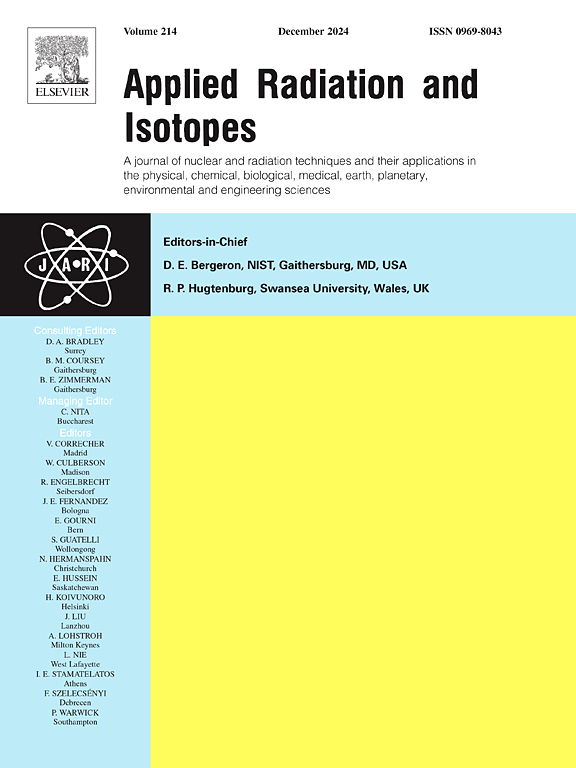Expression rate of LAT1 in high-grade parotid gland carcinoma and potential of BNCT as a treatment option for recurrent parotid gland carcinoma
IF 1.6
3区 工程技术
Q3 CHEMISTRY, INORGANIC & NUCLEAR
引用次数: 0
Abstract
Purpose
Boron neutron capture therapy (BNCT) perform as a treatment option for locally advanced or recurrent unresectable head and neck cancers since June 2020 in Japan. The effect of BNCT on parotid carcinoma, which presents a variety of histologic types, remains unclear. The object of this study was to investigate the antitumor efficacy of BNCT against parotid gland carcinoma by focusing on LAT1, which is involved in the uptake of L-BPA, the boron compound used in BNCT.
Materials and methods
We performed a retrospective review of 42 high-grade parotid gland carcinoma cases. We immunostained specimens using an anti-LAT1 monoclonal antibody to assess the LAT1 expression rate. We divided the patients into two groups: LAT1 expression rate below 10% (negative group) and 10% or higher (positive group), and performed a survival rate analysis.
Results
The study included 42 patients categorized by histological three type into mucoepidermoid carcinoma (MEC), salivary duct carcinoma (SDC), and adenoid cystic carcinoma (AdCC). The LAT1 expression rate in the 42 cases was 37.5%, and the rates for each histological type were: AdCC 15.0%; MEC 17.5%; and SDC 60.0%. The 5-year disease-free survival (DFS) rates were 46.8% in the positive group and 81.8% in the negative group (p = 0.17).
Conclusions
The LAT1 expression rate was 37.5% in cases of high-grade parotid gland carcinoma, and SDC exhibited particularly high expression. From the perspective of LAT1 expression, our results indicated that L-BPA-based BNCT is likely to achieve therapeutic efficacy against parotid gland carcinoma.
高级别腮腺癌中LAT1的表达率及BNCT作为复发性腮腺癌治疗选择的潜力
目的:自2020年6月起,硼中子俘获疗法(BNCT)在日本作为局部晚期或复发性不可切除头颈癌的治疗选择。腮腺癌表现为多种组织学类型,BNCT对腮腺癌的影响尚不清楚。本研究的目的是研究BNCT对腮腺癌的抗肿瘤作用,重点关注与BNCT中使用的硼化合物L-BPA摄取有关的LAT1。材料和方法:我们对42例高级别腮腺癌进行回顾性分析。我们使用抗LAT1单克隆抗体对标本进行免疫染色,以评估LAT1的表达率。我们将患者分为两组:LAT1表达率低于10%(阴性组)和高于10%(阳性组),并进行生存率分析。结果:本研究纳入42例患者,按组织学分为黏液表皮样癌(MEC)、唾液管癌(SDC)和腺样囊性癌(AdCC)三种类型。42例中LAT1的表达率为37.5%,各组织学类型的表达率分别为:AdCC 15.0%;MEC 17.5%;SDC为60.0%。阳性组5年无病生存率(DFS)为46.8%,阴性组为81.8% (p = 0.17)。结论:高级别腮腺癌中LAT1的表达率为37.5%,其中SDC的表达尤其高。从LAT1表达的角度来看,我们的研究结果表明基于l - bpa的BNCT治疗腮腺癌可能达到治疗效果。
本文章由计算机程序翻译,如有差异,请以英文原文为准。
求助全文
约1分钟内获得全文
求助全文
来源期刊

Applied Radiation and Isotopes
工程技术-核科学技术
CiteScore
3.00
自引率
12.50%
发文量
406
审稿时长
13.5 months
期刊介绍:
Applied Radiation and Isotopes provides a high quality medium for the publication of substantial, original and scientific and technological papers on the development and peaceful application of nuclear, radiation and radionuclide techniques in chemistry, physics, biochemistry, biology, medicine, security, engineering and in the earth, planetary and environmental sciences, all including dosimetry. Nuclear techniques are defined in the broadest sense and both experimental and theoretical papers are welcome. They include the development and use of α- and β-particles, X-rays and γ-rays, neutrons and other nuclear particles and radiations from all sources, including radionuclides, synchrotron sources, cyclotrons and reactors and from the natural environment.
The journal aims to publish papers with significance to an international audience, containing substantial novelty and scientific impact. The Editors reserve the rights to reject, with or without external review, papers that do not meet these criteria.
Papers dealing with radiation processing, i.e., where radiation is used to bring about a biological, chemical or physical change in a material, should be directed to our sister journal Radiation Physics and Chemistry.
 求助内容:
求助内容: 应助结果提醒方式:
应助结果提醒方式:


